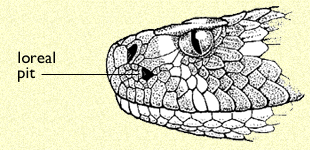


My Wanderings and Ponderings in the Mojave Desert
| Look up torpor in Wiktionary, the free dictionary. |


fossa /fos·sa/ (fos´ah) pl. fos´sae [L.] a trench or channel; in anatomy, a hollow or depressed area. |
Rattlesnakes and other pit vipers have remarkable heat-sensing pits. Located behind each nostril, below a straight line that would directly connect the nostril to the eye, is a loreal pit (called this because it is a depression in the loreal scale). These pits are highly effective in detecting differences in temperature even several yards away. At short ranges within a foot or so, minute differences (of perhaps fractions of a degree) may be perceived.

Heat given off by an animal creates a heat image; therefore, rattlesnakes have “heat vision.” The heat images are integrated with visual ones in the brain. This type of vision is helpful for nocturnal predators, for it enables them to hunt effectively even in total darkness. It may also help distinguish predator from prey, allowing rattlesnakes to determine whether they are at risk themselves. Larger, non-prey animals give off larger heat images, signaling the snakes to avoid potential encounters with these animals.
This is from www.desertmuseum.org

















